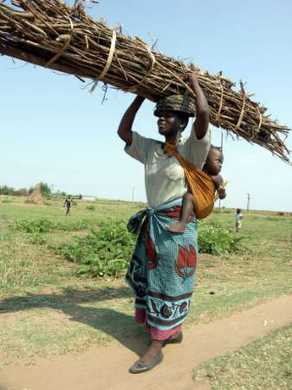Deforestation and erosion starving Malawi
by Ed Stoddard, Reuters
October 13, 2005
CHIKWAWA, Malawi – Jennifer Chikapa is carting Malawi’s future away on her head.
“I’m collecting for firewood, it’s the only fuel I have to cook with,” she said as she paused beneath a baking sun, a pile of slender tree trunks perched on her head and an infant slung on her back.
 A Malawian woman carries wood she has collected for fuel in Chikwawa district, some 90 km (55 miles) south of commercial capital Blantyre, October 12, 2005. Aid officials are concerned over the growing impact of deforestation and say that forest loss and erosion could doom Malawi to perpetual food shortages as the country’s fertile soil is literally swept down to its rivers and flushed out to sea. Picture taken October 12, 2005. PHOTO CREDIT: REUTERS/Eldson Chagara, Photo-journalist |
The wood will last her at least a week as she has little to cook. Aid agencies say around 5 million Malawians — almost half the population of one of the world’s poorest countries — need food aid to get them through to the April maize harvest.
Women like Chikapa are inadvertently adding to their country’s long-term misery.
Forest loss and erosion could doom Malawi to perpetual food shortages as the country’s fertile soil is literally swept down to its rivers and flushed out to sea.
“Malawi’s biggest export is its top soil,” says local conservationist Khalid Hassen.
The evidence can be seen not far from where Chikapa is carrying her wood, in the wide Shire River, which is a deep brown in places, muddied by silt.
Many of the hills that ring the commercial capital Blantyre are heavily farmed, despite their steep slopes. The result is massive erosion of soil.
With around 11 million people occupying a surface area of 118,500 sq km (45,753 sq miles), Malawi is one of Africa’s most densely populated countries.
But much of the arable land has been taken up by commercial plantations growing cash crops such as tobacco, tea and sugar.
This has left millions of subsistence farmers to till what space they can grab.
DEFORESTATION
Deforestation is playing its role as women – seldom men – across the country collect firewood for cooking and cash.
“One of the most common ways that people cope during the lean season is by cutting down trees to sell for charcoal,” said Penelope Howarth, the head of the Blantyre office of the UN World Food Programme.
“This has contributed to widespread flooding and erosion and has a serious impact on long-term food security,” she said.
Loss of forests contribute to erosion because tree roots help to anchor the soil in place.
Food security is already tenuous in Malawi. A drought devastated last spring’s crop and a raging AIDS pandemic has compounded problems, striking down peasant workers in the prime of life.
According to the World Bank, in 2000 – the latest year for which it obtained data – close to 26,000 sq km (10,038 sq miles) of Malawi’s surface area, or 22 percent, was forested.
But forest cover had been declining by an estimated 2.4 percent per year in the preceding decade and may have accelerated since because of subsequent food shortages.
There have been some efforts to reverse this trend through tree-planting programmes sponsored by foreign donors but it is an uphill battle in the face of rapid population growth.
Fragile environments cause problems across Africa from Madagascar, where deforestation is also stripping much of the soil, to the fringes of the vast Sahara desert in West Africa, where the slow creep of the sands is swallowing arable land.
In Malawi, a booming market in wood carvings, which often wind up being sold to tourists in upscale malls in Johannesburg and Cape Town, has also helped lay waste to much of the forests.
Malawi has been dubbed the warm heart of Africa. But its beat is slowing as its lifeblood soil is washed away.
ARTICLE CONTENT COPYRIGHT the Reuters. THIS CONTENT IS INTENDED SOLELY FOR EDUCATIONAL PURPOSES.
mongabay.com users agree to the following as a condition for use of this material:
This site contains copyrighted material the use of which has not always been authorized by the copyright owner. Such material is made available in an effort to advance understanding of environmental issues. This constitutes ‘fair use’ of any such copyrighted material as provided for in section 107 of the US Copyright Law. In accordance with Title 17 U.S.C. Section 107, the material on this site is distributed without profit. If you wish to use copyrighted material from this site for purposes of your own that go beyond ‘fair use’, you must obtain permission from the copyright owner.
If you are the copyright owner and would like this content removed from mongabay.com, please contact me.